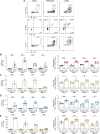Type I interferon signaling in dendritic cells limits direct antigen presentation and CD8+ T cell responses against an arthritogenic alphavirus
- PMID: 39535221
- PMCID: PMC11633147
- DOI: 10.1128/mbio.02930-24
Type I interferon signaling in dendritic cells limits direct antigen presentation and CD8+ T cell responses against an arthritogenic alphavirus
Abstract
Ross River virus (RRV) and other alphaviruses cause chronic musculoskeletal syndromes that are associated with viral persistence, which suggests deficits in immune clearance mechanisms, including CD8+ T-cell responses. Here, we used a recombinant RRV-gp33 that expresses the immunodominant CD8+ T-cell epitope of lymphocytic choriomeningitis virus (LCMV) to directly compare responses with a virus, LCMV, that strongly induces antiviral CD8+ T cells. After footpad injection, we detected fewer gp33-specific CD8+ T cells in the draining lymph node (DLN) after RRV-gp33 than LCMV infection, despite similar viral RNA levels in the foot. However, less RRV RNA was detected in the DLN compared to LCMV, with RRV localizing principally to the subcapsular region and LCMV to the paracortical T-cell zones. Single-cell RNA-sequencing analysis of adoptively transferred gp33-specific transgenic CD8+ T cells showed rapid differentiation into effector cells after LCMV but not RRV infection. This defect in RRV-specific CD8+ T effector cell maturation was corrected by local blockade of type I interferon (IFN) signaling, which also resulted in increased RRV infection in the DLN. Studies in Wdfy4-/-, CD11c-Cre B2mfl/fl, or Xcr1-Cre Ifnar1fl/fl mice that respectively lack cross-presenting capacity, MHC-I antigen presentation by dendritic cells (DCs), or type I IFN signaling in the DC1 subset show that RRV-specific CD8+ T-cell responses can be improved by enhanced direct antigen presentation by DCs. Overall, our experiments suggest that antiviral type I IFN signaling in DCs limits direct alphavirus infection and antigen presentation, which likely delays CD8+ T-cell responses.IMPORTANCEChronic arthritis and musculoskeletal disease are common outcomes of infections caused by arthritogenic alphaviruses, including Ross River virus (RRV), due to incomplete virus clearance. Unlike other viral infections that are efficiently cleared by cytotoxic CD8+ T cells, RRV infection is surprisingly unaffected by CD8+ T cells as mice lacking or having these cells show similar viral persistence in joint and lymphoid tissues. To elucidate the basis for this deficient response, we measured the RRV-specific CD8+ T-cell population size and activation state relative to another virus known to elicit a strong T-cell response. Our findings reveal that RRV induces fewer CD8+ T cells due to limited infection of immune cells in the draining lymph node. By increasing RRV susceptibility in antigen-presenting cells, we elicited a robust CD8+ T-cell response. These results highlight antigen availability and virus tropism as possible targets for intervention against RRV immune evasion and persistence.
Keywords: T cells; T-cell immunity; alphavirus; interferons; viral pathogenesis.
Conflict of interest statement
M.S.D. is a consultant or advisor for Inbios, Vir Biotechnology, IntegerBio, Moderna, Merck, Bavarian Nordic, GlaxoSmithKline, and Akagera Medicines. The Diamond laboratory has received unrelated funding support in sponsored research agreements from Vir Biotechnology, Moderna, IntegerBio, Bavarian Nordic, and Emergent BioSolutions.
Figures








References
-
- Russell RC, Kay BH. 2004. Medical entomology: changes in the spectrum of mosquito‐borne disease in Australia and other vector threats and risks, 1972–2004. Aust J Entomol 43:271–282. doi:10.1111/j.1326-6756.2004.00436.x - DOI
-
- Fraser JR. 1986. Epidemic polyarthritis and Ross River virus disease. Clin Rheum Dis 12:369–388. - PubMed
MeSH terms
Substances
Grants and funding
LinkOut - more resources
Full Text Sources
Molecular Biology Databases
Research Materials
Miscellaneous
